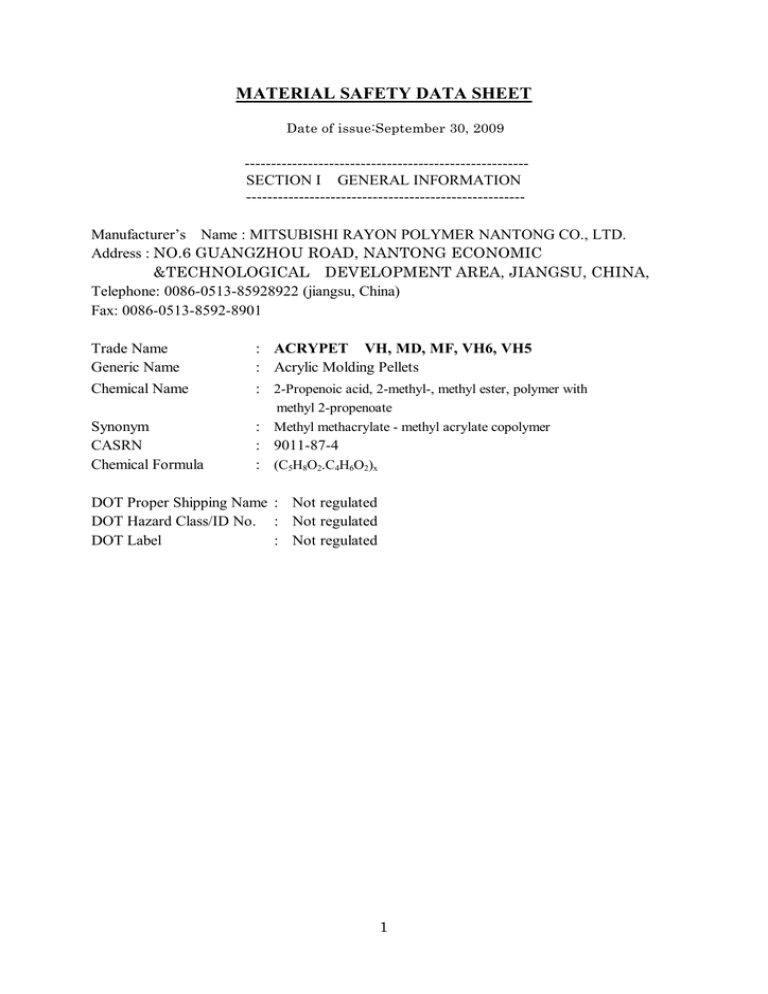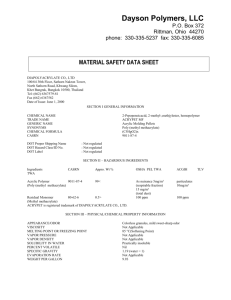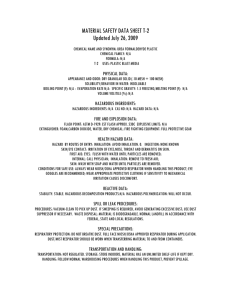ENGLISH ,MSDS_GP .DOC
advertisement

MATERIAL SAFETY DATA SHEET Date of issue:September 30, 2009 -----------------------------------------------------SECTION I GENERAL INFORMATION ----------------------------------------------------Manufacturer’s Name : MITSUBISHI RAYON POLYMER NANTONG CO., LTD. Address : NO.6 GUANGZHOU ROAD, NANTONG ECONOMIC &TECHNOLOGICAL DEVELOPMENT AREA, JIANGSU, CHINA, Telephone: 0086-0513-85928922 (jiangsu, China) Fax: 0086-0513-8592-8901 Trade Name Generic Name : ACRYPET VH, MD, MF, VH6, VH5 : Acrylic Molding Pellets Chemical Name : 2-Propenoic acid, 2-methyl-, methyl ester, polymer with Synonym CASRN Chemical Formula methyl 2-propenoate : Methyl methacrylate - methyl acrylate copolymer : 9011-87-4 : (C5H8O2.C4H6O2)x DOT Proper Shipping Name : Not regulated DOT Hazard Class/ID No. : Not regulated DOT Label : Not regulated 1 --------------------------------------------------------SECTION II HAZARDOUS INGREDIENTS --------------------------------------------------------Ingredients CASRN Approx. Wt.% Acrylic Polymer 9011-87-4 99 < [Poly(methyl methacrylate-methyl acrylate)] Residual Monomer [Methyl methacrylate] 80-62-6 0.5> OSHA PEL TWA As nuisance 5 mg/m3 (respirable fraction) 15 mg/m3 (total dust) 100 ppm ACGIH TLV TWA particulates 10 mg/m3 100 ppm -----------------------------------------------------------------------------------------SECTION III PHYSICAL/CHEMICAL PROPERTY INFORMATION ----------------------------------------------------------------------------------------APPEARANCE/ODOR VISCOSITY MELTING POINT OR FREEZING POINT VAPOR PRESSURE VAPOR DENSITY SOLUBILITY IN WATER PERCENT VOLATILE SPECIFIC GRAVITY EVAPORATION RATE WEIGHT PER GALLON : Colorless granules; mild sweet-sharp odor : Not applicable : : : : : : : : 160℃ (Softening Point) Not applicable Not applicable Negligible Nil 1.19 (water = 1) Not Applicable 9.93 ------------------------------------------------------------SECTION IV FIRE AND EXPLOSION DATA -------------------------------------------------------------FLASH POINT AUTOIGNITION TEMPERATURE UPPER EXPLOSION LIMIT LOWER EXPLOSION LIMIT EXTINGUISHING MEDIA : Not applicable : 421℃ (790゚F) : Not applicable : Not applicable : CO2, dry chemical, water spray, chemical foam 2 SPECIAL FIRE FIGHTING PROCEDURES: This material is a combustible thermoplastic material which will melt and drip when ignited and give off monomers and combustion products which may be toxic. Firefighters and others who may be exposed to products of decomposition and combustion should wear full protective gear including self-contained breathing apparatus. FIRE AND EXPLOSION HAZARDS: Once ignited this material will burn vigorously with intense heat. Dust generated during handling and/or storage of this material can form explosive mixtures with air. ----------------------------------------------SECTION V REACTIVITY DATA ----------------------------------------------STABILITY: Stable CONDITIONS TO AVOID : Polymer decomposition is dependent upon time and temperature. Decomposition will proceed rapidly at temperatures above 300℃ (572゚F). INCOMPATIBILITY: None known. MATERIALS TO AVOID: None known. HAZARDOUS DECOMPOSITION PRODUCTS: Thermal decomposition may yield methyl methacrylate monomer as well as other decomposition products including carbon monoxide and carbon dioxide. HAZARDOUS POLYMERIZATION: Will not occur. CONDITIONS TO AVOID: Not applicable. 3 -------------------------------------------------------SECTION VI HEALTH HAZARD DATA -------------------------------------------------------TOXICITY DATE: Poly (methyl methacrylate) is an experimental tumorigen by implant route. Implant (rat) TDLo: 127 mg/kg equivocal tumorigenic agent Implant (mouse) TDLo: 800 mg/kg equivocal tumorigenic Implant (rat) TD: 1882 mg/kg equivocal tumorigenic agent Implant (mouse) TD: 13 g/kg equivocal tumorigenic agent Implant (mouse) TD: 1280 mg/kg equivocal tumorigenic agent CARCINOGENICITY: IARC: Not classifiable as human carcinogen (Group 3); human evidence – no adequate data, animal evidence -- inadequate. SIGNS AND SYMPTOMS OF EXPOSURE: EYE CONTACT: Dust as well as organic vapors which may be released when the polymer is heated during processing may irritate the eyes. SKIN CONTACT: Dust particles and monomers released during processing may cause irritation of the skin on prolonged or repeated contact. INHALATION: Dust inhalation which may occur at greater than exposure levels (OSHA TWA 5mg/m3 respirable fraction, 15mg/m3 total dust) as well as monomer inhalation which may occur at greater than exposure levels (OSHA TWA 100 ppm) may cause irreversible irritation to the lungs. Low levels of monomer vapors may be generated when the polymer is heated during processing which may cause irritation of the lining of the air passages of the nose, throat and lungs. Nausea, headache and/or dizziness may be experienced. INGESTION: No significant signs or symptoms indicative of any adverse health hazard are expected to occur as a result of ingestion. MEDICAL CONDITIONS GENERALLY AGGRAVATED BY EXPOSURE: Persons with known lung conditions should avoid exposure. 4 EFFECTS OF OVEREXPOSURE: ACUTE : Unknown. CHRONIC : Unknown. EMERGENCY AND FIRST AID PROCEDURES: EYE CONTACT: In case of eye contact, immediately flush with plenty of clean water for twenty to thirty minutes. The eye should be held open and flooded with water so that all surfaces are thoroughly washed. Seek emergency medical attention of pain, blinking, tears or redness persists. SKIN CONTACT: Remove contaminated clothing as needed. thoroughly with plenty of soap and water for a minimum of 15 minutes. Wash affected area INHALATION: Move subject to fresh air. All rescuers should make sure they have proper respiratory equipment operational before attempting rescue. If subject is no longer breathing, mouth-to-mouth resuscitation, artificial respiration or cardiopulmonary resuscitation should be begun immediately. Seek medical attention immediately. INGESTION: If swallowed, dilute by giving 2 glasses of water to drink and obtain emergency medical attention. Placing finger in throat may also be effective in inducing vomiting. Never give anything by mouth to a person if he is unconscious. ---------------------------------------------------------------SECTION VII SPILL OR LEAK PROCEDURES ---------------------------------------------------------------STEPS TO BE TAKEN IN CASE MATERIAL IS RELEASED OR SPILLED: Eliminate all ignition sources. Ventilate area. Avoid breathing dust and vapor. Wear respirator suitable for dust concentration encountered (MSHA/NIOSH-approved or equivalent). Dampen resin with water mist spray and scoop or shovel solid material into a suitable container for recovery or disposal. Keep dust to a minimum. Floor may be slippery; use care to avoid falling. WASTE DISPOSAL METHODS: Place polymer granules in air-tight bag. and federal regulations. Incinerate or landfill according to current local, state 5 --------------------------------------------------------------------------SECTION VIII SPECIAL PROTECTION INFORMATION -------------------------------------------------------------------------VENTILATION TYPE: Provide mechanical local exhaust at point of handling and use. RESPIRATORY PROTECTION: Wear dust respirator (MSHA/NIOSH-approved or equivalent) suitable for concentrations encountered. PROTECTIVE GLOVES: Wear impervious gloves. EYE PROTECTION: Wear safety glasses (ANSI Z-87.1 or approved equivalent). PROTECTIVE CLOTHING: Wear protective clothing when prolonged or frequent exposure to dust and decomposition products are expected. WORK/HYGIENIC PRACTICES: Handle material only in areas with sufficient local exhaust ventilation to maintain airborne concentrations at recognized health and safety levels. Avoid prolonged breathing of vapors and decomposition products. Avoid eye contact. Wash hands thoroughly before eating or drinking. Do not smoke when handling or using product. OTHER PROTECTIVE EQUIPMENT: Provide eyewash fountain and safety shower. 6 ----------------------------------------------------SECTION IX SPECIAL PRECAUTIONS ----------------------------------------------------PRECAUTIONS TO BE TAKEN IN HANDLING AND STORAGE: When handling and processing the material, local exhaust ventilation may be required to control polymer dust and reduce exposure to organic vapors and other odors. To prevent dust explosions employ bonding and grounding for operations capable of generating static electricity. Protect all equipment from explosions by following the guidelines in NFPA-68 and NFPA-69. For electrical equipment follow local codes and electrical classification NFPA-70, National Electrical Code Class II, division II, group G. Storage of the material may be done indoor or outdoor. The storage temperature should not exceed 60℃ (140゚F). In the case of indoor storage, the storage area should be limited to areas equipped with automatic sprinklers. Avoid all ignition sources. Avoid high concentrations of dust in air and accumulation of dust on equipment. A fine dust of this material can create a dust explosion. ----------------------------------------------------------SECTION X REGULATORY INFORMATION ----------------------------------------------------------METHYL METHACRYLATE (CASRN 80-62-6) is listed under CERCLA Hazardous Substances subject to Section 304; and Toxic Chemicals subject to Section 313. It is also listed under OSHA Air Contaminants; ACGIH TLV Chemicals; and IARA Unclassifiable as well as the Right To Know Hazardous Substance List for the State of New Jersey and the Hazardous Substance List of the State of Pennsylvania. ******* COMPREHENSIVE ENVIRONMENTAL RESPONSE, COMPENSATION AND LIABILITY ACT (CERCLA) 40 CFR 302.4 Requires notifying the National Response Center of release of quantities of Hazardous Substances equal to or greater than the reportable quantities (RQs). 7 Components present in this product at a level which could require reporting under the statute are: METHYL METHACRYLATE ******* SUPERFUND AMENDMENTS AND REAUTHORIZATION ACT SARA TITLE III, 1986 40 CFR 355 (ALSO SARA 302, 304, 311 & 312) Emergency planning based on Threshold Planning Quantities (TPQs) and release reporting based on Reportable Quantities (RQs). Components present in this product at a level which could require reporting under the statute are: METHYL METHACRYLATE RQ = 1000 lbs. ******* 40 CFR (FOR SARA 313) Submission of annual reports of release of toxic chemicals that appear in this information must be included in all MSDSs that are copied and distributed for this material. Components present in this product at a level which could require reporting under the statute are: METHYL METHACRYLATE ******* ------------------DISCLAIMER ------------------The information contained in this Material Safety Data Sheet was compiled from sources which we believe are reliable and to represent the most reasonable current opinion on the subject when the Material Safety Data Sheet was prepared. However the information is provided without any warranty, guaranty or representation, express or implied, regarding its correctness or sufficiency. The user of this product must decide for itself what means are 8 necessary to safely use this product, either alone or in combination with other products. 9



